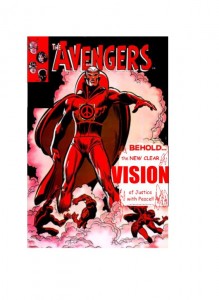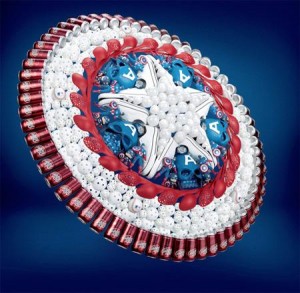The Avengers’ New Vision
Peace and Justice Activists, Assemble!
by Matt Meyer
It has been one of those life-affirming weeks. When something that has been a part of you for decades finally gets the attention and admiration you’ve felt it has deserved all along, a special pride is evoked; you can now pass it coolly and smoothly on to your own  children and to the next generation. I’m speaking, of course, of the new, mainstream Hollywood blockbuster: the Avengers.
children and to the next generation. I’m speaking, of course, of the new, mainstream Hollywood blockbuster: the Avengers.
OK, by now the reader may be wondering if they are viewing the correct website, where movie reviews of major new releases, especially apparently militaristic ones, are not commonly lauded. Allow me to explain, or rather — to confess. Since about age eight, now more than forty years ago, I have been a more-than-avid Avengers fan-boy. At first, it was just a simple reader’s favorite, one of many comic books which sparked my imagination at a young age. As I grew older, however, and the others were swept aside and replaced by passionate interests in music, and then my grown-up commitment to the movements for social change, the Avengers remained a faithful reminder of fun things past and maybe possible; I’d take my vacations each August finding a comic book shop and buying the past years’ worth of stories, catching up on old friends. When I landed my first substantial paycheck, one of my first acts (after paying numerous bills!) was to go to a local comic convention and fill in the “blanks†of my still-preserved Avengers collection — including the rare and wonderful “first issue.â€Â Over the past ten years or so, as fatherhood and work responsibilities (and a depressed economy) have made it harder to find time or money to keep up on a weekly basis, I have still made stops to my local shop a part of my monthly routine. I’ve never written “fan fiction†or obtained the on-line status of some super-fans, such as the amazing Javis-head-authors associated with the “Assembled†books, but there is evidence to suggest that my commitment to this franchise runs long and deep.
What then has motivated a life-long nonviolent activist to keep up a devotion to men in tights who smash things? Why, as a boy brought up in a pacifist-leaning household (my parents weren’t activists but gasped at the Vietnam War images flashed across our television), was I caught by such a craze? The striking images of Jack Kirby, or — later — of the incomparable George Perez and others, certainly played a role. But clearly the defining feature was the character development and relationships, expertly crafted by Stan Lee, and developed by many excellent writers over the course of time. And, in Lee’s inimitable style, these heroes had “issues,†as my son would say — their own sets of character flaws which made them all the more human and relatable to the young folks (mainly boys) who comic books were supposed to attract back in those days. Put together in a team, you had some page-turning sparks fly which had nothing to do with battling “bad guys.†This is what Comix.com writer Mindy Newell correctly characterized as “group dynamics†— the gel which made the Avengers so consistently interesting.
Maybe these are just rationalizations, but I’m inclined to think that some of the basic moral principles I was raised in, and the revolutionary nonviolence and social justice commitments to which I’ve subsequently dedicated my life and writings, are in some ways embedded in (and have therefore been influenced and supported by) the stories of “Earth’s Mightiest Heroes.†Perhaps we need look no further than the Black Panther: that fantastic 1966 addition to the team, coming on just a short time before my youthful readings began. Though not formally connected to the militant self-defense and liberation organization (the Panther’s first appearance pre-dates the founding of the Oakland-based organization by a few months), the character still embodied an amazing array of progressive Pan-Africanist features for the time. A head-of-state of a stridently non-aligned, independent African nation (the fictionalized Wakanda, both politically and economically free from colonial control, with strong, nationalized mineral and nationalistic human resources), T’challa (the Panther’s real name) is part-diplomat, part-scientist, part-acrobatic defender; his super-power is how he balances these skills for the good of his and all people. For a boy not quite ready to read Malcolm or Martin, the tales of T’challa in the context of the multi-national (and internationalist) Avengers team were an inspiring lens through which to view a late-1960s frame.
After the Black Panther, my favorite Avenger, coming onto the team just a few issues later, was (and is) the Vision. Part-human, part-“synthezoid†(a synthetic, robot-like deep thinker), the Vision looked cool — in green and yellow and red — and was an amazing cross between otherworldly and strangely familiar. Though it barely occurred to me directly until thinking about my pre-teen son now and my pre-teen self then, there is no way that the Vision didn’t typify the confusion and angst of our “tween†dilemmas. The Vision clearly has feelings, but doesn’t understand or connect to them very well; his powers literally involve the ability to get very hard and/or nearly intangible. He is brilliant and clunky, all-powerful and yet awkwardly vulnerable. As I described the prospect of taking my son and his best friend to a New York IMAX 3D showing on the first day of release, followed by an Avengers-themed sleepover: “Earth’s Mightiest Hormones!â€
To understand the Avengers, one must understand the women — from founding member Janet Van Dyne (the Wasp, a survivor of domestic abuse who goes on to lead the team), the Black Widow (another internationalist: a Russian double agent and spy), the all-powerful Scarlett Witch (who literally shapes and bends realities, but can’t quite face the reality that she and the Vision can’t have children). And then there is the Hulk, prominent in the current box-office smash, but not a serious part of the team past the first few issues. Cultural critic and Black feminist bell hooks has brilliantly deconstructed the problematic issues of an apparently white-guy genius who turns into a huge, stupid, menacing man-of-color when he gets angry; the FEMINIST HULK of recent twitter fame plays on those issues in uncannily gender-bending (and often anti-racist) ways.
Then there are the big three: the triumvirate of Captain America, Thor, and Iron Man. Philosopher Mark D. White handily analyzes the “Avengers Prime,†along with an array of other issues and others scholars in the recently published The Avengers and Philosophy: Earth’s Mightiest Thinkers. In dividing the teams’ mainstays into three basic schools of thought and action — utilitarianism, deontology, and virtue ethics — White poses some vital issues regarding the ideas underlying the close-to-fifty-years of text. For me, though, the center of the fray is always “the Captain†— our patriotic embodiment of justice who somehow avoids the trappings of racism, sexism, or imperialism. Few realize that Steve Rogers (Cap’s civilian identity) resigned the position during the Contra Wars of the Reagan era, unwilling to front for unjust wars. In addition, though any cursory glance would note that the Avengers do regular battle, the fact is that Steve Rogers — while certainly not an abolitionist as far as prisons are concerned — always wants to avoid violence and is principally opposed to taking a life. This has not always been seen as positive or practical by the rest of the team, but Cap’s unavoidably superior strategic and leadership skills usually end up with him getting his way; the Avengers use just enough force to get the job done. This dance of the dialectic — between nonviolence and armed self-defense, if you will — is not one unfamiliar to those of us in the fields of peace studies and social movements.
The new movie is worth seeing. One need not know anything about the Avengers comic book history, or superheroes at all, to enjoy  the carefully scripted and paced conglomeration of action scenes, humor, and relationship-building. Social issues exist in some forms — from the sojourn to India where solidarity work is being done in a poor village, to recognition of the complicated questions of who the real liars and criminals are, who is really giving orders to whom, and who is really designing and producing weapons of mass destruction. Like the best parts of the books, however, the movie’s most dramatic moments are not in the heat of battle, but over the debates about whether and how these different special beings are going to unite and get along. It takes a friend’s demise to help bring the individualistic heroes to the realization than an alliance is both worthy and needed; the villain is vanquished not so much because he is outnumbered or outgunned, but because, ultimately, it is clear that he lacks conviction, fighting as he is for a cause that is so unjust.
the carefully scripted and paced conglomeration of action scenes, humor, and relationship-building. Social issues exist in some forms — from the sojourn to India where solidarity work is being done in a poor village, to recognition of the complicated questions of who the real liars and criminals are, who is really giving orders to whom, and who is really designing and producing weapons of mass destruction. Like the best parts of the books, however, the movie’s most dramatic moments are not in the heat of battle, but over the debates about whether and how these different special beings are going to unite and get along. It takes a friend’s demise to help bring the individualistic heroes to the realization than an alliance is both worthy and needed; the villain is vanquished not so much because he is outnumbered or outgunned, but because, ultimately, it is clear that he lacks conviction, fighting as he is for a cause that is so unjust.
Was I reading too much into things when, on May 1, 2012 — the day of general strike called for by Occupy Wall Street as well as labor and immigrant rights groups — the Avengers franchise were asked to open the floor of the New York Stock Exchange … and they chose the actor playing the evil Loki, god of mischief, to represent the film? Am I just seeing things when the big letter “A†which adorns all Avengers materials seems to me a call for anarcho-socialist revolution!? Perhaps I should leave it to the simple message my son and his friend came up with when I asked them for a quote for this article: “It is one of the best movies I have ever seen, dad.â€
And yet, and yet … while I can’t condone the crazy commercial blitz which the Avengers are currently undergoing (do we really need an Avengers deodorant? do we need to use an image of Cap’s shield to sell soda pop, wiffle balls, spatulas, and sneakers?), I remain struck by how the Avengers set me on a path of coalition-building. It is not only a needed, but also a worthy goal; the movements for social change in this country are too dispersed, too separated and uncoordinated and out of touch. We progressives could use a good rallying cry for the ages: “Peace and justice activists, ASSEMBLE!” We’ve got a world to save.
Matt Meyer is an educator-activist, based in New York City, and serves as convener of the War Resisters International Africa Working Group. His recent books include Guns and Gandhi in Africa: Pan-African Insights on Nonviolence, Armed Struggle and Liberation (Africa World Press, 2000), the two-volume collection Seeds of New Hope: Pan African Peace Studies for the 21st Century (Africa World Press, 2008, 2010), and Let Freedom Ring: A Collection of Documents from the Movements to Free U. S. Political Prisoners (PM Press, 2008). Meyer is a contributing member of the Editorial Advisory Board for New Clear Vision.
{Pickups: Truthout}
